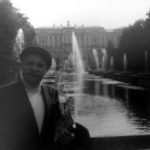Photo above: Rabbi David Hill during his trip to the USSR in 1981. (Citation: Photographs and Negatives, 1981-1982. David Hill Papers; P-888; box 1, folder 8; American Jewish Historical Society, New York, NY, and Boston, MA.)
Project Update: Digitization of Soviet Jewry collections from the American Jewish Historical Society
Thanks to generous support from the National Historical Publications & Records Commission (NHPRC), the Center for Jewish History is completing the digitization of more than 75,100 images and 500 audio hours from the American Jewish Historical Society’s Soviet Jewry collections this month.
The American Soviet Jewry movement emerged from small grassroots groups of students and others outside the establishment in the early 1960s. It evolved into a worldwide phenomenon throughout the early ‘90s, and was integral to the emigration of hundreds of thousands of Soviet Jews who had been forbidden to embrace any part of their cultural and religious traditions throughout the Cold War era.
The Gruss Lipper Digital Lab’s staff of photographers and information professionals are pleased to have completed over 75,100 images and 500 hours of digital audio files on the Digitizing American Soviet Jewry Movement Collections initiative. The lab’s equipment includes Canon DSLR cameras, Epson flatbed scanners, a Tascom audio workstation and a Better Light camera for oversized and fragile materials.
Among the collections’ objects are political posters, photographs, trip reports, ephemera and audiocassettes. Each object goes through a meticulous process of digital capture, quality assurance, post-production, metadata enhancement and ingest into the Center’s Digital Collections.
In addition to digitizing the records of organizations such as the National Conference on Soviet Jewry and the Bay Area Council for Soviet Jewry, the team has digitized material related or pertaining to such noted figures as Avital and Natan Sharansky and a wealth of American human rights activists.
—
Highlight from the Digitized Collections: Trip report by Rabbi David Hill
One of the pioneers of the American Soviet Jewry movement, New York City-based Rabbi and manufacturer of kosher meat products David Hill, came to the US from Latvia in 1930. Influenced by his Family’s fortunate escape from the Holocaust, he became aware of and concerned about the situation of the Soviet Jews in the late 1950s. As the national president of National Council of Young Israel, he made attempts to place the issue of Soviet Jewry on the agenda of the Conference of Presidents of Major American Jewish Organizations as early as 1961. During that period, the National Council of Young Israel began financially supporting Jewish life in the USSR by mailing the Soviet Jewish communities packages of goods with high value on the local black market, such as fur and leather garments.
During the early 1960s, Rabbi Hill worked hard to explore new ways to help Soviet Jews and raised the issue in meetings with such notable religious and political figures as John F. Kennedy, Golda Meir, David Ben-Gurion and Menachem Mendel Schneerson. Starting in the mid-1970s, he helmed Operation Lifeline, an independently funded outreach program created by NCSJ Commission on Education and Culture. The purpose of the program was to help Soviet Jews learn and practice Jewish religion and culture. For that purpose the program shipped and distributed kosher food and Jewish religious and cultural literature in the Soviet Union. It enlisted and subsidized qualified people to travel and teach Hebrew, religion and culture in Soviet Jewish communities. The program briefed and supplied American Jews who travelled to the USSR to meet Soviet Jews, collect information on their situation and offer Soviet Jews material and spiritual aid. Among the many successful special projects of the program was supplying kosher food and Haggadot for annual Passover Seders held in the United States Embassy in Moscow and the special delivery of 10,000 pounds of matzo to Ukraine to fulfill a shortage during Passover of 1991. This detailed report documents one of many trips to the Soviet Union made by Rabbi Hill to personally assess the current situation and needs of the Soviet Jewish communities, hand-deliver educational materials and financial aid, determine the future course of action for Operation Lifeline, and to visit old friends and make new ones.
This detailed report is digitized and available online: click here to access the material. (Citation: Hill, Rabbi David, 1981. National Conference on Soviet Jewry collection; I-181A; box 63, folder 14; American Jewish Historical Society, New York, NY, and Boston, MA)
Information on Rabbi David Hill provided by Andrey Filimonov.

